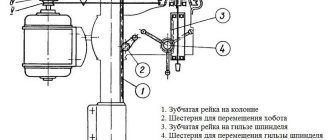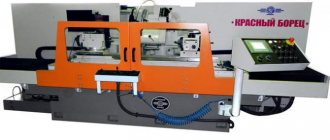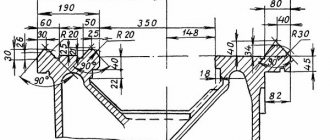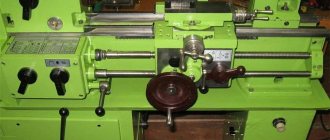Thanks to the constant development of science, namely the synthesis of new polymers, high-tech materials are emerging that are widely used in many areas of industry. Today, some polymers not only successfully compete with metals and their alloys, but in some cases are considered to have better characteristics than them.
One of the most common new high-tech materials is caprolon , the properties of which are superior to metal in many respects, including strength and corrosion resistance.
Appearance and main characteristics
Caprolon is a polymer material that is white with yellowish color and odorless. The shade of the polymer can change due to various dyes or additives that are added to it during production.
One of the key properties of the polymer is its strength, which is not inferior to steel, as well as a wide operating temperature range from -40 to +80 degrees, thanks to which it can be used in different climatic zones or in extreme conditions.
Most often, caprolon is associated with a substitute for metals and alloys in parts that are subject to significant wear due to friction forces. The antifriction properties of the material allow it to be used as gaskets and bearings.
It is absolutely waterproof and has a high level of corrosion resistance; it can work for a long time in various aggressive environments:
- sea water;
- fuel (gasoline, kerosene, diesel);
- dilute acids and alkaline solutions;
- alcohols.
Due to its dielectric properties, caprolon is successfully used in the manufacture of electric motors and insulating components.
The weight of the polymer is 6 times less than steel, which has significantly increased its popularity. Structures with parts made of caprolon instead of iron are lightweight, which in some cases is a critical indicator.
The material is subject to all types of mechanical processing, thanks to which it is possible to manufacture the necessary part from it with a fairly high class of surface accuracy.
Kaprolon
CAPROLON - GOST, TU
Currently, we offer high-quality caprolon (sheet, rod, bushing) produced by Metafrax OJSC, Gubakha, Perm Territory. This caprolon (polyamide 6 block) is produced according to TU 2224-036-00203803-2012 in two grades A and B.
Caprolon - technical characteristics.
Technical characteristics of caprolon according to TU2224-036-00203803-2012 PA 6 grade A B (sheet, rod, sleeve)
| Indicator name | Norm | |
| Grade A | Brand B | |
| Appearance | Sheets, sleeves, rods are white to cream in color with a smooth surface without chips or pits | |
| Thickness of the monomer layer, mm, no more | 3 | 5 |
| Number of pores no larger than 1.5 mm per 1000 mm² surface area | None | 5 (10) |
| Bending stress at a deflection value equal to 1.5 sample thickness, MPa, not less | 90 | 80 |
| Shock resistance | Does not collapse | Tests are carried out according to GOST |
Reference indicators of caprolon B
| Indicator name | Indicator value |
| Density, kg/m³ | 1150-1160 |
| Melting point, °C | 220-225 |
| Breaking tensile stress, MPa | 70-85 |
| Relative extension,% | 10-25 |
| Stress at compressive strain equal to 25%, MPa | 100-130 |
| Dielectric constant at a frequency of 10 to the 6th power Hz | 3,0-3,3 |
| Friction coefficient for steel | 0,2-0,3 |
| Impact strength, kJ/m², not less than: without cut with notch | 120 3 |
| Content of extractable substances, % | 2,0-4,0 |
Caprolon is supplied to the consumer without packaging. Marking is done by gluing a label, or using a stamp with indelible paint.
Transportation of caprolon B is possible by all types of covered transport.
Caprolon is produced in sheets (sheet caprolon) with a size of 1000*1400 mm and a thickness of 10 to 300 mm, rods with a length of 500 to 1000 mm and a diameter of 20 to 815 mm. Caprolon bushings are produced with a length of up to 1400 mm, an outer diameter from 80 to 580 mm, and an inner diameter from 30 to 460 mm.
Technical characteristics of caprolon G (graphite-filled polyamide 6) according to TU2224-036-00203803-2012 (sheet, rod, sleeve)
| Indicator name | Norm |
| Appearance | Sheets, bushings, rods of dark gray color with a smooth surface without chips or cavities |
| Number of pores no larger than 1.5 mm per 1000 mm² surface area | 10 |
| Bending stress at a deflection value equal to 1.5 sample thickness, MPa, not less | 95 |
Reference indicators of caprolon G (graphite-filled polyamide 6)
| Indicator name | Indicator value |
| Density, kg/m³ | 1160-1170 |
| Melting point, °C | 215-220 |
| Breaking tensile stress, MPa | 65-80 |
| Relative extension, % | 10-25 |
| Stress at compressive strain equal to 25%, MPa | 120-140 |
| Dielectric constant at a frequency of 10 to the 6th power Hz | 3,5-4 |
| Friction coefficient for steel | 0,2-0,25 |
| Impact strength, kJ/m², no less: without notch with notch | 40 4 |
Sheets, rods and bushings made of caprolon G (graphite-filled polyamide 6) are produced in the same sizes as caprolon B. The same applies to transportation, storage, packaging and shelf life of graphite-filled caprolon.
We also offer to buy caprolon (sheet rod) produced in China (China)
Scope of application of caprolon.
Thick-walled and non-standard parts for structural, electrical and antifriction purposes (electrical insulating bushings, rings, gaskets) are made from caprolon blocks and rods. They also produce coil frames, parts for relays, switches, and magnetic starters. High strength and elasticity, wear resistance have made it possible to use caprolon (polyamide 6) for many industries. Good electrical insulating properties, corrosion and chemical resistance have made caprolon indispensable for machine and instrument making, automotive aviation and medical industries. Gears, bearing shells, various fasteners, blades of ship propellers, ship mechanisms operating under active influence of sea water, fans, bushings, electrical insulating parts, medical instruments, coatings with chemical resistance, as well as for the manufacture of gears and parts are made from caprolon. pumps and filters. Caprolon bearings and other rubbing parts can operate without lubrication or with little lubrication. Therefore, the use of rubbing parts made of caprolon is especially rational in the textile and food industries, where lubrication is not desirable due to operating conditions, as well as in units where lubrication is difficult. Products made from caprolon can withstand loads closer to the loads permissible for non-ferrous metals and alloys. The wear resistance of caprolon is 6-10 times greater than that of metals.
Properties of caprolon.
Both sheet (plate made of caprolon) and rod caprolon have increased impact strength and wear resistance. Caprolon is resistant to oil, gasoline, alkalis and weak acids. Caprolons are self-extinguishing. Tropical resistance - TC in conditions excluding direct solar irradiation. Caprolon (Polyamide PA 6) has an average degree of hydrophobicity, but high moisture and water resistance due to the high density of the structure and the absence of hydroxides in the chemical structure.
Production of caprolon.
Caprolon is obtained by polymerization of E-caprolactam, in the presence of alkaline catalysts with the addition of N-acetyl-E-caprolactam as a cocatalyst or with the addition of metallic Na and CO2. Aliphatic polyamides (PA) PA 6 block (caprolon sheet) are produced according to TU 6-05-988-83; 22 2422).Produced by injection molding and extrusion. Caprolone is produced in the form of blocks (sheet caprolone) and rods of various weights and sizes. Polymerization of caprolactam in the presence of a catalyst and activator occurs at a temperature below the melting point of the polymer at atmospheric pressure. Alkali and alkaline earth metals can be used as catalysts. Activators can be N - acetyl - derivatives of lactam (acetyl capraloctam). The process of obtaining products consists of the following stages: preparation of raw materials, preparation of solutions, production of prepolymers, molding of products. — Preparation of raw materials. Caprolactam is dried to a moisture content of 0.1% (no more), and then melted in a melter at a temperature of 100-110 ° C. Caprolactam can be dried in a vacuum drying oven at a temperature of about 50 ° C or in a drying oven with air recirculation. The most rational way to dry caprolactam is in an inert gas environment in row or drum dryers. During the melting of caprolactam, residual moisture is removed from it (under a pressure of 0.02 MPa) by inert gas supplied to the lower part of the melter. The permissible final moisture content of the caprolactam melt is not higher than 0.02% - Preparation of solutions. From the melter, caprolactam is fed through a filter cartridge into two separate reactors - mixers; in the first, a catalyst is added to it, and in the second, an activator. When mixing caprolactam with a catalyst, the temperature should not exceed 110 °C. The temperature of mixing caprolactam with the activator depends on the pouring temperature and can vary from 120 ° C to 140 ° C - Preparation of the prepolymer. Solutions of the catalyst and activator in caprolactam from the mixers are supplied to the prepolymerizer. The required equivalent ratio of catalyst and activator is achieved by simultaneous supply of solutions through a pipeline of equal cross-section. When the solutions are mixed, a prepolymer is formed, which flows through the filling device into pre-prepared and heated molds. Polymerization is carried out in a heat chamber at a temperature of 160-180 ° C for approximately 1 hour. - Molding of products. In the molds, the process of synthesizing the polymer and molding products from caprolon (polyamide 6) simultaneously takes place. The type of activator used affects the density and degree of crystallinity of the polymer. Semi-functional activators promote the formation of caprolon with a branched and cross-linked structure, which, complicating crystallization, leads to the absence of a clearly defined spherulite structure and a decrease in the rigidity of the polymer. Polymerization occurs most completely with an equivalent ratio of the components of the catalytic system, when there is one group of activating compound per functional group of the catalyst. Increasing the concentration of one of the components either slows down or completely stops the polymerization process. The optimal concentration of the catalytic system is 0.3-0.4% (mol.), which ensures the production of high-quality caprolon. The molding temperature significantly affects the entire process of producing caprolon, as well as its properties and quality of finished products. The temperature of the prepolymer depends on the activator, the mass and configuration of the caprolon product, and should be in the range of 120-140 ° C. At lower temperatures, caprolon is obtained with a heterogeneous structure, and therefore of lower quality. At elevated temperatures, caprolon quickly hardens, as a result of which air does not have time to escape from it, and numerous pores, cavities and cracks form. The exposure time varies from 0.5 to 2 hours. For thicker products, the holding time increases. The cooling rate should not be high - in this case, caprolon will have a homogeneous structure, good surface and high physical and mechanical characteristics. Recommended speed is from 5 to 10-12 C°/h. Rejected products go into production waste and, after grinding, can be reused (as an additive in an amount of 15-20%) to produce cast caprolon. The production of caprolon has lower costs than the production of another polymer - fluoroplastic. In connection with this, the price of caprolone is much lower. Graphite-filled (black) and colored (colored) caprolone is produced by casting or extruding caprolactam with the addition of mineral fillers, heat- and light-resistant pigments and dyes, as well as colloidal graphite. You can buy from us graphite-filled caprolon from stock in St. Petersburg.
Processing of caprolon.
Caprolon can be machined. Products with a thickness (or diameter) over 100 mm must be subjected to heat treatment. This is important to obtain accurate parts and to avoid cracking of the product. Heat treatment is carried out in oil, paraffin, water and air. - Heat treatment in oil, paraffin: temperature 140-160°C. Duration from 10 to 15 minutes per 1 mm thickness (diameter) of caprolon. Then slowly cool to 20-30 °C. Heat treatment in water: temperature 94-98 °C for (7+0.04*X) hours, where X is the thickness (diameter) of caprolon in mm. Then slowly cool in water to 30-35 ° C. Heat treatment in air: temperature 160-180 ° C for (3 + 0.02 * X) hours, where X is the thickness (diameter) of caprolon in mm. Then carry out slow cooling at a rate of no more than 2 °C per hour to a temperature of 140 °C, then the cooling rate can be increased to 10 °C per hour.
Storage of caprolon.
Blocks (sheets) and rods made of caprolon (polyamide 6) are stored in closed warehouses.
Safety precautions during the production and processing of caprolon.
Cast and extruded caprolon, and products made from it are non-toxic and do not have a harmful effect on the human body. During the processing of caprolon 230-280 C° there is no decomposition of the material and no release of harmful substances. At temperatures above 300 C°, caprolon (polyamide) decomposes, releasing carbon monoxide and carbon dioxide and ammonia. The maximum permissible concentration of carbon monoxide in the room is 20 mg/m³. In this regard, production premises must be equipped with supply and exhaust and local ventilation.
Shelf life (storage) of caprolon.
The guaranteed shelf life of caprolon (polyamide 6 block, rod) is 4 years. You can find out the price and buy caprolon (polyamide 6) wholesale and retail by contacting the managers of our organization. Delivery of caprolon to all regions of Russia has been organized.
Technical specifications
Despite the relative youth of the material and recent use (no more than 30 years), its scope of application is expanding, and its popularity is growing , largely due to its properties and characteristics.
Caprolon, technical characteristics:
- density (g/cm3) from 1.135 to 1.16 depending on the brand and modification;
- tensile strength (MPa) from 70 to 100;
- the maximum permissible temperature range for long-term operation is +110 degrees, and for short-term operation it can reach +150 degrees;
- subject to melting at a temperature of 225 degrees.
Just a small part of the technical parameters shows the high strength and wear resistance of caprolon.
Capralon rods
The assortment includes rods made of natural, black and modified caprolon produced by ANION.
Tolerance on rod length ± 4%. Upon request, semi-finished products can be cut into specified sizes.
Caprolon rods with a diameter of 50 to 255 mm are available for free sale; rods of greater thickness are made to order.
| Ø mm | Tolerance Ø mm | Length mm | Ø mm | Tolerance Ø mm | Length mm |
| 50,0 | +3,00 | +40 1000 +120 3000 | 190,0 | +5,00 | +40 1000 |
| 55,0 | 200,0 | ||||
| 60,0 | 210,0 | ||||
| 65,0 | 215,0 | ||||
| 70,0 | 220,0 | ||||
| 75,0 | 230,0 | ||||
| 80,0 | 235,0 | ||||
| 85,0 | 240,0 | +9,00 | |||
| 90,0 | 245,0 | ||||
| 95,0 | 250,0 | ||||
| 100,0 | 255,0 | ||||
| 105,0 | +5,00 | +40 1000 | 260,0 | ||
| 110,0 | 265,0 | ||||
| 115,0 | 275,0 | ||||
| 120,0 | 285,0 | ||||
| 125,0 | 290,0 | +11,00 | +40 500 | ||
| 130,0 | 300,0 | ||||
| 135,0 | 330,0 | ||||
| 140,0 | 350,0 | ||||
| 145,0 | 360,0 | ||||
| 150,0 | 400,0 | ||||
| 160,0 | 430,0 | ||||
| 165,0 | 450,0 | ||||
| 170,0 | 460,0 | ||||
| 180,0 | 500,0 |
Capralon bushings
The assortment includes bushings made of natural, black and modified caprolon produced by ANION.
- Dн - nominal outer diameters of bushings.
- Dв - nominal internal diameters of bushings.
The bushings are manufactured with an allowance for machining ΔDн and Δ Dв, the maximum allowance is indicated in the table.
| Dн, mm | ΔDн, mm | ΔDв, mm | Length, mm | Dн, mm | ΔDн, mm | ΔDв, mm | Length, mm |
| 50,0 | +3,00 | -4,50 | +25 1000 | 220,0 | +9,00 | -10,00 | +25 1000 |
| 60,0 | 230,0 | ||||||
| 65,0 | 235,0 | ||||||
| 75,0 | 240,0 | ||||||
| 80,0 | 250,0 | -12,00 | +25 1030 | ||||
| 85,0 | +3,50 | -5,00 | 260,0 | ||||
| 90,0 | 270,0 | ||||||
| 95,0 | 280,0 | ||||||
| 100,0 | 290,0 | ||||||
| 105,0 | 300,0 | +11,00 | -14,00 | ||||
| 110,0 | 310,0 | +25 960 | |||||
| 115,0 | 320,0 | +25 1030 | |||||
| 120,0 | +5,00 | -6,50 | 340,0 | ||||
| 125,0 | 360,0 | ||||||
| 130,0 | 380,0 | ||||||
| 135,0 | 390,0 | +25 1030 | |||||
| 140,0 | 400,0 | +13,00 | -16,00 | +25 1030 | |||
| 145,0 | 480,0 | ||||||
| 150,0 | -7,50 | 500,0 | +15,00 | -18,00 | +25 +20 1030 / 500 | ||
| 160,0 | 600,0 | ||||||
| 165,0 | 700,0 | +25 500 | |||||
| 170,0 | 710,0 | +25 1030 | |||||
| 180,0 | 800,0 | +25 500 | |||||
| 185,0 | 810,0 | +20,00 | -20,00 | +25 1030 | |||
| 190,0 | +6,00 | -8,50 | 900,0 | +25 +20 1030 / 500 | |||
| 200,0 | 980,0 | +25 1030 | |||||
| 210,0 | 1000,0 |
Areas of use
Due to its properties and technical characteristics, caprolon is successfully used in many industries. It is most common in the following areas:
- electrical engineering. Being a dielectric, caprolon is considered an excellent option for insulating power cables; protective casings for electrical equipment that operate outdoors are also made from it. Due to its low galvanoelectric corrosion, this polymer is used to make terminals, coils, switches and connectors. Resistance to alkaline solutions makes it possible to use the material in contact with various electrolytes;
- mining, shipbuilding and mechanical engineering. Due to its low weight, the use of caprolon makes it possible to lighten the design several times and significantly reduce costs without loss of quality due to the lowest cost of the material compared to similar polymers. The material is used to make sliding bearings, hubs, cuffs, rock crusher drums and much more.
Advantages
Parts made of caprolon are durable and remarkably absorb shock loads , due to which they are used for the manufacture of trolleys, housings of various mechanisms, gearbox drives, conveyors, hubs, gears, sprockets and many other units in which there are shock loads on the product body or elements. Polyamide rods and sheets are resistant to:
- alcohol;
- alkalis;
- oils;
- ether;
- weak acid.
Parts made from this material are used in friction units and even without lubrication. The advantage of sheet and rod caprolon is that it is an excellent dielectric, its qualities are not inferior to materials such as polyvinyl chloride and polystyrene.
With a low coefficient of friction, Polyamide 6 products are quickly and easily installed in place of steel and bronze parts. In addition, they are much lighter in weight than metal products.
Sheet or rod caprolon is perfectly processed on sharpening, milling and grinding machines. Products made from such material guarantee more reliable and long-lasting service in friction and sliding units. Caprolon rods can withstand various loads and impacts, and are also characterized by a long service life.
Comparison with analogues
There are many different polymers that have high strength, wear resistance and can replace metal, and caprolon is only one of them. The most common question is “caprolon or fluoroplastic - which is better?”
There is no definite answer, since both materials, although similar, still have individual characteristics and features.
If we take heat resistance, then fluoroplastic will be better, since it can be used at temperatures up to 200 degrees, while caprolon will begin to melt in this mode.
In terms of resistance to chemical corrosion, both materials have approximately the same characteristics, with the only difference being that fluoroplastic is used more in chemically active acidic environments, and caprolon in alkaline ones.
If we consider the weight, then caprolon will be lighter than fluoroplastic, which gives wider possibilities for its use in highly specialized areas where the weight of the product plays a big role.
In terms of compressive strength and tensile or impact deformation coefficient, caprolon is slightly inferior to fluoroplastic.
Despite the fact that the service life of fluoroplastic is longer than that of caprolon, and it is recognized as a more durable and reliable material, caprolon is considered the most affordable and parts made of this polymer will cost much less than similar structures made of fluoroplastic.
What is the difference between caprolon and fluoroplastic?
The differences between caprolon and fluoroplastic are not entirely noticeable at first glance, especially for an inexperienced person. Externally, these materials have a smooth surface and a color ranging from white to light cream, but they can still be distinguished externally. The highest quality fluoroplastic is almost white, dense, uniform in color, very slippery to the touch (similar to snow-white soap), when struck it makes a dull sound, it can be easily scratched, and a mark remains if pressed with a fingernail. Caprolon (polyamide) is creamier in color, less slippery, hard (no marks remain when pressed with a fingernail), and if you tap on it, the sound will be loud. The weight of fluoroplastic is twice (










